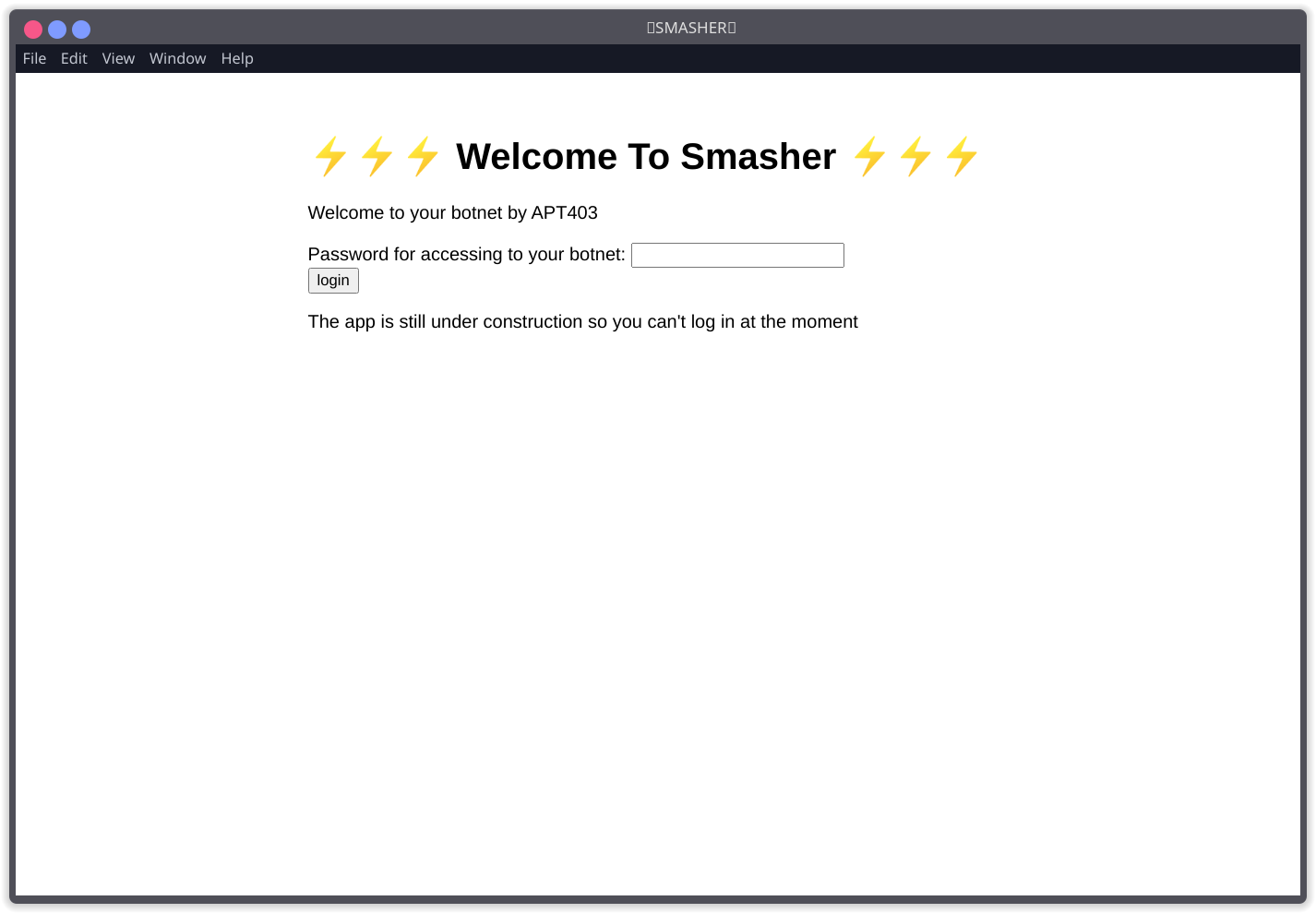Writeup Cyber Threat Force : Smasher
For this challenge, we were given two files:
smasher-1.0.0.AppImagesmasher_Setup_1.0.0.exe
I only looked at the AppImage one, since I’m running linux. Launching the program reveals an electron app:

We can simply use the dev tools to reveal the source code. Only one javascript file is there, login.js:
function Login() {
var i = {
_keyStr: "ABCDEFGHIJKLMNOPQRSTUVWXYZabcdefghijklmnopqrstuvwxyz0123456789+/=",
encode: function(r) {
var t, e, o, a, n, c, h = "", d = 0;
for (r = i._utf8_encode(r); d < r.length; )
o = (c = r.charCodeAt(d++)) >> 2,
a = (3 & c) << 4 | (t = r.charCodeAt(d++)) >> 4,
n = (15 & t) << 2 | (e = r.charCodeAt(d++)) >> 6,
c = 63 & e,
isNaN(t) ? n = c = 64 : isNaN(e) && (c = 64),
h = h + this._keyStr.charAt(o) + this._keyStr.charAt(a) + this._keyStr.charAt(n) + this._keyStr.charAt(c);
return h
},
decode: function(r) {
var t, e, o, a, n, c = "", h = 0;
for (r = r.replace(/[^A-Za-z0-9\+\/\=]/g, ""); h < r.length; )
t = this._keyStr.indexOf(r.charAt(h++)) << 2 | (o = this._keyStr.indexOf(r.charAt(h++))) >> 4,
e = (15 & o) << 4 | (a = this._keyStr.indexOf(r.charAt(h++))) >> 2,
o = (3 & a) << 6 | (n = this._keyStr.indexOf(r.charAt(h++))),
c += String.fromCharCode(t),
64 != a && (c += String.fromCharCode(e)),
64 != n && (c += String.fromCharCode(o));
return c = i._utf8_decode(c)
},
_utf8_encode: function(r) {
r = r.replace(/\r\n/g, "\n");
for (var t = "", e = 0; e < r.length; e++) {
var o = r.charCodeAt(e);
o < 128 ? t += String.fromCharCode(o) : (127 < o && o < 2048 ? t += String.fromCharCode(o >> 6 | 192) : (t += String.fromCharCode(o >> 12 | 224),
t += String.fromCharCode(o >> 6 & 63 | 128)),
t += String.fromCharCode(63 & o | 128))
}
return t
},
_utf8_decode: function(r) {
for (var t = "", e = 0, o = c1 = c2 = 0; e < r.length; )
(o = r.charCodeAt(e)) < 128 ? (t += String.fromCharCode(o),
e++) : 191 < o && o < 224 ? (c2 = r.charCodeAt(e + 1),
t += String.fromCharCode((31 & o) << 6 | 63 & c2),
e += 2) : (c2 = r.charCodeAt(e + 1),
c3 = r.charCodeAt(e + 2),
t += String.fromCharCode((15 & o) << 12 | (63 & c2) << 6 | 63 & c3),
e += 3);
return t
}
}
, r = document.login.password.value;
"Q1lCRVJURntNMFIzX04zZzR0MXYzX3RoNG5fNF9wcjB0MG59" == i.encode(r) ? (alert("Welcome to admin panel"),
location.replace("https://www.youtube.com/watch?v=dQw4w9WgXcQ")) : alert("wrong password")
}
That bottom string is compared with the password that we can enter, and looks like base64. Let’s try to decode it:
> atob('Q1lCRVJURntNMFIzX04zZzR0MXYzX3RoNG5fNF9wcjB0MG59')
"CYBERTF{M0R3_N3g4t1v3_th4n_4_pr0t0n}"
And so we have our flag: CYBERTF{M0R3_N3g4t1v3_th4n_4_pr0t0n}.
Note that I didn’t flag this during the CTF, my teammate R0ck3t did.
You can view the sources on github or read other writeups.
Read other posts